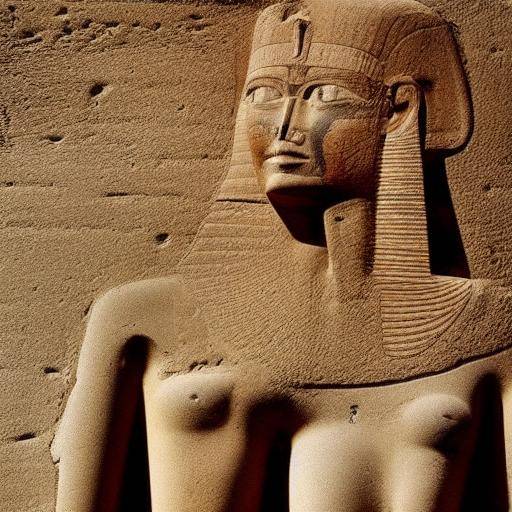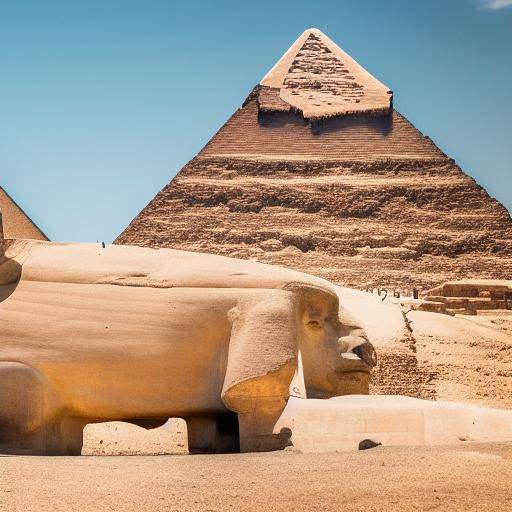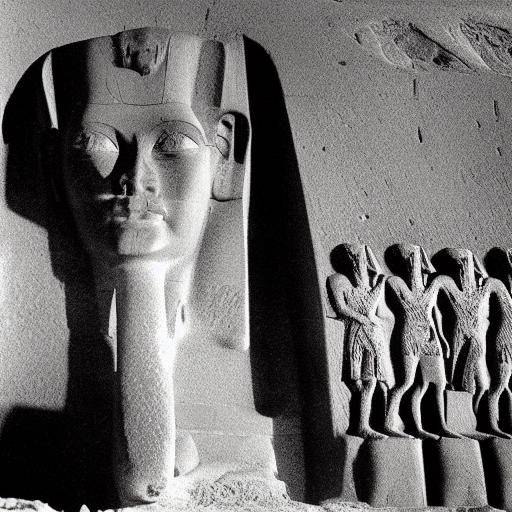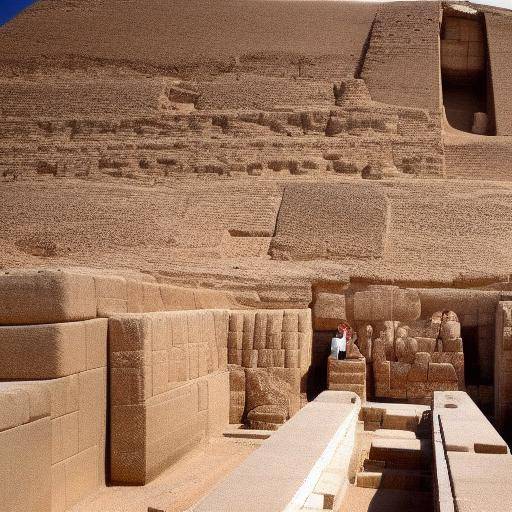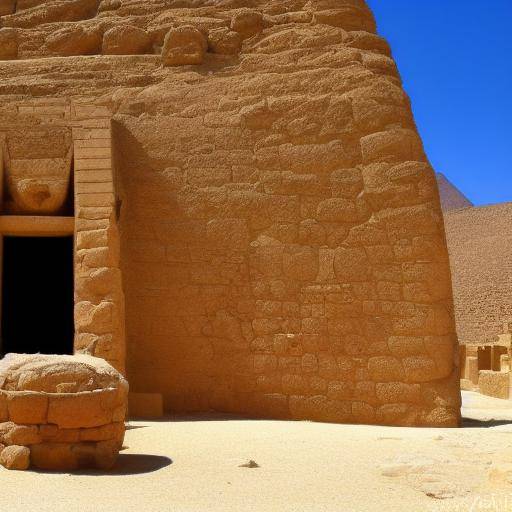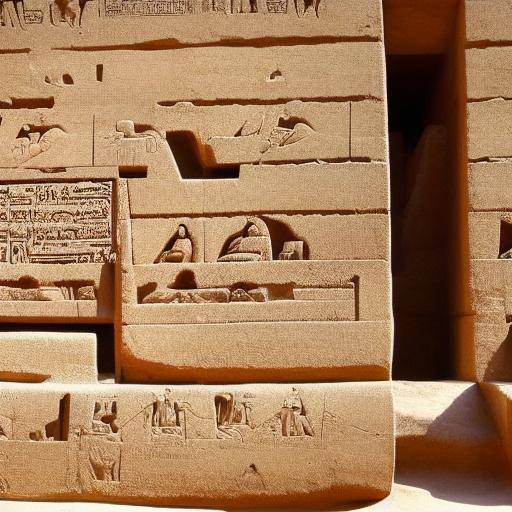
The Great Sphinx of Giza has fascinated mankind for millennia with its mysteries and riddles. The nearby archaeological excavations and discoveries have shed new light on the rich history of ancient Egypt. In this article, we will explore the shocking history, the exciting discoveries and current trends in Egyptian archaeology, offering a comprehensive view of these exciting issues. From the majesty of the Great Sphinx to the latest innovations in archaeology, this article will immerse you in an exciting journey through time and culture.
Introduction
The Great Sphinx of Giza, known for its enigmatic presence in front of the pyramids of Egypt, has been a lasting symbol of the greatness and mystery of ancient Egypt. Its construction dates back to about 4,500 years, making it one of the oldest structures in the world. However, the mysteries surrounding the Great Sphinx go beyond their age; their original purpose, the meaning of their face and the symbolism they embody continue to be themes of debate and speculation among archaeologists, egyptologists and enthusiasts of ancient history.
In the vicinity of the Great Sphinx of Giza, numerous archaeological excavations have revealed significant findings that have broadened our understanding of ancient Egypt. From hidden treasures to astonishing inscriptions, these discoveries have triggered a renewed interest in Egyptian archaeology and have driven innovative research that promise to unravel more hidden secrets under the sands of the desert. This article will give a detailed look at these exciting discoveries, as well as the current trends and advances in Egyptian archaeology, providing a deeper understanding of this fascinating civilization and its legacy.
History and Background
The Great Sphinx of Giza, sculpted in the limestone rock, represents a mythical creature with lion body and human head, usually associated with the pharaoh. Its construction is commonly attributed to Pharaoh Keops, of the Old Empire, approximately in 2500 BC. However, the sphinx has witnessed several historical periods and has been the subject of multiple interpretations and theories over the centuries.
The first formal excavations near the Great Sphinx began in the nineteenth century, by European egyptologists and archaeologists. These initial efforts revealed hieroglyphic inscriptions that provided valuable information on the construction and symbolic significance of the sphinx, but also triggered debates and disputes over their true purpose and origin.
Throughout the twentieth and twenty-first century, excavations and discoveries near the Great Sphinx of Giza have shown an amazing diversity: from everyday artifacts to sumptuous tombs, revealing a wealth of details about the life and beliefs of ancient Egyptian civilizations. With the advance of technology, archaeological research has acquired a multidisciplinary character, using methods such as photogrammetry, laser scanning and radiocarbon dating to reveal new aspects of Egyptian history.
The most recent discoveries have challenged preconceived notions, such as the identification of new pyramids and previously unknown funeral complexes, as well as the renewed understanding of Egyptian spirituality and technology. These findings provide a more nuanced and complete look at one of the most fascinating civilizations in history.
Analysis in Deep
Egyptian archaeology, especially in the environment of the Great Giza Sphinx, has experienced a rebirth in recent decades, driven by technological advances and an interdisciplinary approach. The incorporation of remote sensing, radiocarbon dating and digital reconstruction has opened new perspectives to understand Egyptian history and culture. These technological advances have allowed archaeologists to reinterpret and re-evaluate previous findings, as well as to discover completely new evidence that sheds light on unknown aspects of ancient civilization.
In addition, Egyptian archaeology has become an interdisciplinary field of study covering scientific and humanistic disciplines, which has enriched the understanding of the culture, society and technology of ancient Egypt. For example, collaboration between archaeologists, anthropologists, egyptologists, geologists and conservation specialists has shed new lights on the construction of pyramids, funeral practices and the daily lives of ancient Egyptians.
The current challenges of Egyptian archaeology include the preservation of cultural heritage against urbanization and tourism, as well as the sustainable management of archaeological sites. As Egypt strives to balance the preservation of historical legacy with modern development, archaeology plays a vital role in the conservation and understanding of the country's rich cultural heritage.
Comprehensive review
In a constantly evolving world, Egyptian archaeology continues to offer valuable knowledge that transcends the borders of time and space. Its applications go beyond mere academic research: heritage conservation, cultural tourism and education are areas where archaeology plays a key role. The discoveries around the Great Sphinx of Giza not only enrich our understanding of ancient Egypt, but also promote public awareness of the importance of preserving world cultural heritage.
The innovative practices and methodologies used in Egyptian archaeology, such as three-dimensional documentation and digital preservation, have potential applications in other fields of study and in the management of cultural heritage worldwide. The legacy of Egyptian archaeology transcends national borders, serving as a global benchmark for understanding the evolution of humanity and ancient civilizations.
In analyzing the methods and approaches used in excavations near the Great Sphinx of Giza, it is possible to identify practices and strategies that could be applied in other areas of global archaeology, thus contributing to a more comprehensive and collaborative approach to archaeological research.
Comparative analysis
When comparing the Great Sphinx of Giza, Giza in general and Egyptian archaeology with other archaeological sites and cultures, both similarities and significant differences stand out. While the majesty and mystery of the Great Sphinx of Giza distinguish it as a unique icon of antiquity, other sites such as the Acropolis of Athens or Machu Picchu offer a variety of equally fascinating cultural and architectural contexts.
Egyptian archaeology is characterized by its wealth and diversity, ranging from Pharaonic monuments to the remains of rural settlements, which distinguishes it as an exceptionally complete field of study. The sophistication of the construction techniques and the wealth of the funeral traditions of Egyptian culture make it a unique research area that continues to inspire archaeologists and history enthusiasts around the world.
Practical Tips and Accessible Tips
If you are interested in exploring Egyptian archaeology and ancient history, consider participating in volunteer programs or archaeological excursions that offer opportunities to engage directly in research and preservation of Egyptian heritage. In addition, the reading of specialized literature and attendance at conferences or exhibitions related to Egyptian archaeology can enrich your understanding and appreciation of this fascinating field.
If you are looking to contribute to the field of Egyptian archaeology, consider supporting organizations dedicated to the preservation of cultural heritage, participating in volunteer projects or donating to institutions that conduct archaeological research in Egypt. Your contribution can play a crucial role in protecting and disseminating the rich heritage of ancient Egypt.
Industry Perspectives and Expert Reviews
Advances in the field of Egyptian archaeology have aroused the interest of scholars, professionals and enthusiasts alike. The industry's perspectives aim at greater integration of emerging technologies, such as artificial intelligence and virtual reality, to improve the documentation, visualization and interpretation of archaeological findings. These advances promise to enrich the experience of exploring the ancient history of Egypt and promoting greater access to archaeological information.
Experts on Egyptian archaeology have expressed optimism about the potential of interdisciplinary approaches and global collaboration to address the challenges of conservation and study of Egyptian heritage. They recognize the importance of involving the local community and stakeholders in preservation efforts, as well as the need to promote public awareness of the importance of protecting Egypt ' s cultural legacy.
Case Studies and Applications in Real Life
Numerous case studies have demonstrated the relevance and impact of Egyptian archaeology on the understanding of ancient history. The identification and preservation of real tombs, the discovery of ancient buried cities and the recovery of historical artifacts have significantly contributed to the understanding of ancient Egypt and its legacy.
Archaeological findings have also had a lasting impact on education and cultural tourism, enriching public knowledge about the history and culture of Egypt. Museums and archaeological sites that exhibit Egyptian artifacts attract visitors from around the world, fostering greater appreciation for the wealth of Egyptian heritage.
Future Trends and Predictions
The future of Egyptian archaeology is characterized as a vibrant and constantly evolving field. Technological advances are expected to continue to play a crucial role in the documentation, preservation and interpretation of Egyptian archaeological sites. The integration of geographic information systems, massive data analysis and three-dimensional digital models promises to revolutionize the way we understand and preserve the heritage of Egypt.
In addition, there is a growing emphasis on international collaboration and knowledge-sharing in the field of Egyptian archaeology, which will allow greater access to the resources and experience needed to address contemporary challenges in the preservation and study of Egyptian heritage.
Conclusion
In short, the Great Sphinx of Giza and nearby archaeological excavations continue to fascinate the world with their shocking discoveries and potential to reveal new aspects of Egypt's history. Egyptian archaeology, with its rich legacy and global importance, represents a crucial field for understanding and preserving the cultural heritage of mankind.
Advances in Egyptian archaeology not only benefit our understanding of the past, but also provide valuable insights to address contemporary challenges, such as the preservation of cultural heritage and the promotion of cultural tourism. As we dive deeper into the study of the Great Sphinx, Giza and Egyptian archaeology, it is clear that these disciplines play a fundamental role in the connection between the past, the present and the future. With a continuous focus on innovation, collaboration and preservation, Egyptian archaeology will continue to inspire and enrich our lives for generations to come.
Frequently asked questions
1. What is the importance of the Great Sphinx of Giza in Egyptian archaeology?
The Great Sphinx of Giza has been instrumental in understanding Egyptian history and culture. Its location close to the pyramids and its monumentality have raised intriguing questions about its purpose and its connection with other structures in Giza. His archaeological study has shed light on the iconography, symbolism and the construction technique of ancient Egypt, playing a central role in the field of Egyptian archaeology.
2. What are the current challenges facing Egyptian archaeology?
Egyptian archaeology faces challenges such as managing the growing flow of tourists in archaeological sites, the sustainable conservation of cultural heritage and the preservation of archaeological sites against urban development. Furthermore, the need for financial and technological resources to carry out excavations and sustainable studies is a crucial aspect for the future of Egyptian archaeology.
3. How can I contribute to the field of Egyptian archaeology from abroad?
There are various ways of supporting Egyptian archaeology from abroad, such as participating in volunteer programmes, donating organizations that promote the conservation of Egyptian heritage, and promoting awareness of the importance of preserving Egypt ' s cultural legacy through knowledge dissemination and support for research projects.
4. What are the most used technologies in the current Egyptian archaeology?
Egyptian archaeology has adopted cutting-edge technologies such as photogrammetry, laser scanning, remote sensing and radiocarbon dating, which have revolutionized the way archaeological sites are studied and preserved. These techniques allow more precise documentation, three-dimensional visualization and advanced scientific analysis of archaeological findings.
5. What impact does Egyptian archaeology have on education and cultural tourism?
Egyptian archaeology has had a significant impact on education by enriching public understanding of the history and culture of Egypt. It has also contributed to the development of cultural tourism by attracting visitors from around the world to Egyptian archaeological sites, fostering greater appreciation for the wealth of Egyptian heritage and its influence on humanity.
6. What advances are expected in Egyptian archaeology in the coming years?
It is projected that Egyptian archaeology will experience a greater focus on sustainable conservation, the integration of emerging technologies such as artificial intelligence and virtual reality, and a closer global collaboration to address contemporary challenges. These advances are expected to enrich our understanding and preservation of Egyptian cultural heritage.
Concluding, the Great Sphinx of Giza is more than an ancient wonder: it is a living testament of human grandeur and creativity. Through Egyptian archaeology and archaeological spaces such as Giza, we continue to unravel the mysteries of the past and trace the steps of ancient civilizations. May this article inspire greater appreciation for the magnificence of the Great Sphinx, Giza and Egyptian archaeology; that promotes lacuriosity by history and its mysteries, and that promotes the protection and preservation of our shared cultural heritage. The Great Sphinx of Giza, with its eternal gaze towards the horizon, invites us to explore, discover and learn, and through archaeology, we continue to respond to its ancient call in the search for knowledge and understanding.

